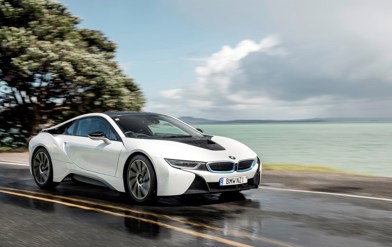If a Mercedes-Benz G-Wagen was a similar size and price to a Toyota Fortuner, you might end up with this: the GWM Tank 300.
An odd pairing perhaps, but it illustrates a couple of very important things about this new 4x4 from GWM (you know, the company that brings us the Cannon ute and all those Haval SUVs). First, it’s definitely a “4x4”: body-on-frame chassis with proper 4WD and low-range transfer. A “ute with a boot” as we sometimes call this genre, because it’s an SUV based on heavy duty pickup-truck underpinnings (from the Cannon), just like Fortuner (Hilux) or the larger Ford Everest (Ranger).

Second, it aims to be very much a luxury SUV, with a G-Wagen-inspired cabin and extremely high level of standard equipment: all the touchy feely bits and all the active safety features (not to mention a freshly stamped five-star ANCAP rating). When it was launched in China back in 2020, the Tank 300 was actually sold under GWM’s Wey luxury brand, but it’s since been spun off into its own thing – under the GWM umbrella in this part of the world.
There’s a third aspect to the Tank 300 that makes it especially interesting: a full hybrid powertrain, combining a 2.0-litre turbo engine and nine-speed automatic transmission with electrified architecture to make an impressive 258kW/615Nm. You can drive for very short distances on EV power and it can mix-and-match petrol and electric power as needed, recharging the battery during coasting and braking.
That’s a trio of talents that could make the Tank 300 unique in the market.
We’ve just driven the new model at the Australian Automotive Research Centre (AARC) near Melbourne, as part of a GWM media day. It was just one part of a grab-bag of new product (stay tuned, more later), so full disclosure: time was limited... and limited to off-tarmac driving.

Obviously, on-road driving is crucial to the Tank equation, because that’s where it will spend most of its time. But for now, the AARC was a great place for the 300 to show it has the right stuff off-road, with dedicated test courses including axle-articulation, sections of rocky road (not the delicious kind), various climbs/descents and a 600mm wading pool.
The 300 stacks up on paper, with 224mm ground clearance and approach/departure angles of 33/34deg; it can also tackle a 70 per cent gradient (that’s steep). A rear differential lock is standard, but there’s also a front lock on the flagship version.
The Tank pretty much shrugged off all the AARC could throw at it, in the process offering a few surprise-and-delight off-roading features such as the Land Rover-style Chassis Perspective (which uses the forward camera to create a view of what’s under your “invisible” car on the infotainment screen) and “Tank Turn”, which brakes the inside-rear wheel to tighten the turning circle in close quarters.

It was also illuminating to drive the hybrid back-to-back with a Chinese-specification Tank petrol GWM had on hand (complete with Wey badges on the grille). The hybrid has more power of course (the standard 2.0-litre turbo is 180kW), but more importantly the battery fills in the gaps low down. The low-speed slog over rough terrain feels effortless in the hybrid compared with the standard petrol, which relies much more on its transmission and engine revs to keep things moving.
The Tank 300 hybrid is already on sale in Australia and the standard petrol is mooted for the second quarter; however, neither are confirmed for New Zealand at this stage.
There are a few boxes that still need to be ticked for Kiwiland. The official fuel consumption figure is one, given it has an impact on potential Clean Car Discount/Standard status.

Here’s the rub: NZ is now a very hybrid-aware market and the 300’s fuel economy is perhaps not as impressive as some buyers lured by the HEV badge might expect. Sure, it’s a hybrid, but it’s also 2331kg; the car was originally homologated for Australia at 10.3l/100km, a figure which GWM is now trying to get revised at an official level (yes, apparently you can do that).
“We actually believe it’s significantly less than that,” says GWM head of marketing and communications Steve Maciver, who reckons a figure in the 8s is more relevant to the vehicle’s potential. A 3P-WLTP-converted figure under 8.3l/100km would (just) escape a Clean Car fine in NZ, so that could be key to showroom appeal.
“We need to completely understand what it looks like in terms of the Clean Car tax and that’s the work we’re doing right now,” says Maciver. “Then, ultimately, we need to go out to the market and understand whether we think there’s a business case.

“As soon as we finalise that – and it shouldn’t take too long to do – we can make a decision. Speaking to some of our [NZ] dealers, the overwhelming feedback is that there is an opportunity for it. But I think it needs to be the hybrid.”
Maciver is also quick to remind that the hybrid stuff is not just about fuel economy: “It’s also there to improve torque and driveability. That’s why we chose to launch Tank 300 with hybrid technology first, to give us the best possible driving experience.”
In Australia, Tank 300 pricing starts about 20 per cent above the top Haval H6 HEV, rising $5k for the flagship model. So call it $60k for the Tank 300 Lux in NZ and about $65k for the posh Ultra with larger wheels, automatic parking, Nappa leather, grunty sound system and an extra differential lock.
GWM TANK 300 HYBRID
ENGINE: 2.0-litre turbo-petrol four with full hybrid system including electric motor
POWER: 258kW/615Nm (combined)
GEARBOX: 9-speed automatic, 4WD with low range transfer
CONSUMPTION: 10.3-8.3l/100km, to be confirmed
PRICES: $60,000-$65,000 (DRIVEN estimate)
















